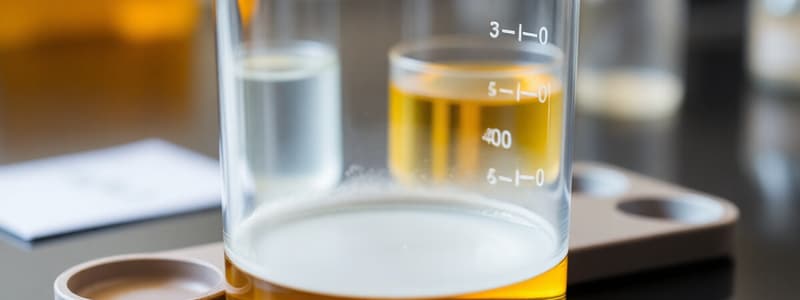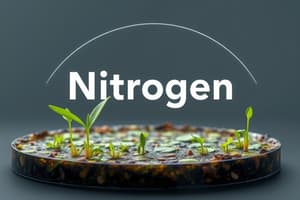Podcast
Questions and Answers
What is the spring constant (k) of the spring balance?
What is the spring constant (k) of the spring balance?
- 1225 N/m
- 3600 N/m
- 490 N/m
- 2450 N/m (correct)
Using the formula for the period of oscillation, what is the mass (m) of the oscillating system?
Using the formula for the period of oscillation, what is the mass (m) of the oscillating system?
- 22.34 kg (correct)
- 30 kg
- 15.25 kg
- 29.47 kg
What information is required to calculate the weight (W) of the body using the formula W = m·g?
What information is required to calculate the weight (W) of the body using the formula W = m·g?
- Spring length and spring constant
- Volume of water and temperature
- Mass of the body and acceleration due to gravity (correct)
- Density of the body and spring length
What is the calculated weight (W) of the body in Newtons?
What is the calculated weight (W) of the body in Newtons?
What is the value of the force (F) exerted by a mass of 50 kg due to gravity?
What is the value of the force (F) exerted by a mass of 50 kg due to gravity?
What does the extension of the spring (x) equal when 50 kg is applied to the spring balance?
What does the extension of the spring (x) equal when 50 kg is applied to the spring balance?
In the oscillation formula T = 2π√(m/k), what does T represent?
In the oscillation formula T = 2π√(m/k), what does T represent?
When calculating the oscillation period, which quantity is NOT necessary?
When calculating the oscillation period, which quantity is NOT necessary?
What is produced during the Dumas method as the end product?
What is produced during the Dumas method as the end product?
Which substance is used in the Kjeldahl method as the oxidation agent?
Which substance is used in the Kjeldahl method as the oxidation agent?
How is nitrogen content calculated using the Dumas method?
How is nitrogen content calculated using the Dumas method?
What is the molar volume at STP used in the nitrogen content calculation?
What is the molar volume at STP used in the nitrogen content calculation?
Which method is suitable for a wide range of compounds, including soil and fertilizer analysis?
Which method is suitable for a wide range of compounds, including soil and fertilizer analysis?
What reaction occurs when ammonium sulfate ((NH4)2SO4) is treated with an alkali in the Kjeldahl method?
What reaction occurs when ammonium sulfate ((NH4)2SO4) is treated with an alkali in the Kjeldahl method?
What is the primary application of the Dumas method?
What is the primary application of the Dumas method?
Which compounds is the Dumas method NOT suitable for?
Which compounds is the Dumas method NOT suitable for?
What does the nitrogen content equation in Kjeldahl's method utilize to assess the nitrogen percentage?
What does the nitrogen content equation in Kjeldahl's method utilize to assess the nitrogen percentage?
In the Kjeldahl method, what is the significance of liberating ammonia gas?
In the Kjeldahl method, what is the significance of liberating ammonia gas?
Flashcards
Dumas Method
Dumas Method
A method used to determine the percentage of nitrogen in organic compounds. It involves converting nitrogen to molecular nitrogen (N2) gas, which is then measured.
Principle of Dumas Method
Principle of Dumas Method
The principle behind the Dumas method is that when an organic compound is heated strongly in the presence of excess oxygen or cupric oxide, carbon and hydrogen are oxidized to CO2 and H2O, while nitrogen is liberated as N2.
Reactions in Dumas Method
Reactions in Dumas Method
In the Dumas method, the organic compound is mixed with cupric oxide (CuO) and heated strongly. This reaction oxidizes carbon and hydrogen to CO2 and H2O, respectively, while nitrogen is liberated as N2 gas.
Kjeldahl's Method
Kjeldahl's Method
Signup and view all the flashcards
Principle of Kjeldahl's Method
Principle of Kjeldahl's Method
Signup and view all the flashcards
Reactions in Kjeldahl's Method
Reactions in Kjeldahl's Method
Signup and view all the flashcards
Applications of Dumas and Kjeldahl's Methods
Applications of Dumas and Kjeldahl's Methods
Signup and view all the flashcards
Significance of Dumas and Kjeldahl's Methods
Significance of Dumas and Kjeldahl's Methods
Signup and view all the flashcards
Kjeldahl's Method (Step 1: Digestion)
Kjeldahl's Method (Step 1: Digestion)
Signup and view all the flashcards
Kjeldahl's Method (Step 2: Liberation)
Kjeldahl's Method (Step 2: Liberation)
Signup and view all the flashcards
Kjeldahl's Method (Step 3: Absorption)
Kjeldahl's Method (Step 3: Absorption)
Signup and view all the flashcards
Kjeldahl's Method (Step 4: Titration)
Kjeldahl's Method (Step 4: Titration)
Signup and view all the flashcards
Dumas Method (Principle)
Dumas Method (Principle)
Signup and view all the flashcards
Dumas Method (Oxidation Agent)
Dumas Method (Oxidation Agent)
Signup and view all the flashcards
Kjeldahl's Method (Oxidation Agent)
Kjeldahl's Method (Oxidation Agent)
Signup and view all the flashcards
Dumas Method (Applicability)
Dumas Method (Applicability)
Signup and view all the flashcards
Kjeldahl's Method (Applicability)
Kjeldahl's Method (Applicability)
Signup and view all the flashcards
Study Notes
Dumas Method
- Principle: Converts nitrogen in an organic compound to nitrogen gas (N₂).
- Process: Organic compound heated with excess oxygen or cupric oxide (CuO). Carbon and hydrogen oxidize to CO₂ and H₂O, while nitrogen is released as N₂.
- Procedure: Known mass of the compound is mixed with excess CuO, heated in a combustion tube. Product gases (N₂, CO₂, H₂O) are passed through a solution absorbing CO₂ and H₂O. Volume of N₂ is measured.
- Calculation:
- % Nitrogen = (Volume of N₂ * Molar Mass of N * 100) / (Mass of sample * Molar Volume at STP)
- Molar Volume at STP = 22.4 L/mol
Kjeldahl's Method
-
Principle: Converts nitrogen in an organic compound into ammonium sulfate ((NH₄)₂SO₄) using concentrated sulfuric acid (H₂SO₄). Ammonium sulfate is then treated with alkali to liberate ammonia gas (NH₃).
-
Process: Organic compound is digested with concentrated H₂SO₄ and a catalyst in a sealed container. Liberated NH₃ is absorbed in a known volume of standard acid solution (e.g., HCl).
-
Procedure: Organic compound is digested with concentrated H₂SO₄ and a catalyst. Digest is neutralized, liberating NH₃. NH₃ is distilled into a known volume of standard acid solution.
-
Calculation:
- % Nitrogen = (Volume of acid reacted * Normality of acid * 14 )/ (Mass of sample * 1000)
- 14 is the atomic mass of nitrogen
-
Suitable for: Wide range of compounds, commonly used in agriculture, food, and biochemistry for protein analysis.
Differences between Methods
| Feature | Dumas Method | Kjeldahl's Method |
|---|---|---|
| Principle | Nitrogen to N₂ | Nitrogen to NH₃ |
| Oxidation Agent | Cupric oxide (CuO) | Sulfuric acid (H₂SO₄) |
| End Product | Molecular nitrogen (N₂) | Ammonia (NH₃) |
| Measurement | Volume of N₂ gas | Titration of absorbed NH₃ |
| Applicability | Limited to organic compounds without halogens or sulfur | Suitable for a wide variety of organic compounds |
Studying That Suits You
Use AI to generate personalized quizzes and flashcards to suit your learning preferences.




